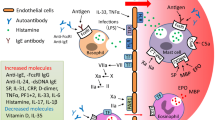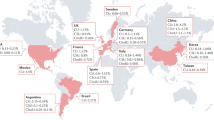Abstract
Chronic urticaria (CU) is a skin disorder characterized by the recurrent eruption of short-lived wheals accompanied by redness and itching for at least 6 weeks. The wheals can be associated with angioedema. CU is considered an autoimmune disease in about 50% of cases with the presence of circulating histamine releasing autoantibodies mainly directed against the high affinity IgE receptor FcεRI on mast cells and basophils or against IgE. In several CU cases regarded as idiopathic; the actual pathophysiological mechanisms are still unknown. Some patients with CU do not respond to antihistamines and require the use of systemic steroids or cyclosporin, which are, however, not always effective. In CU, several investigators have demonstrated the activation of coagulation that is due to the involvement of eosinophils and a tissue factor pathway with generation of thrombin potentially contributing to an increased vascular permeability. CU patients often present with elevation of coagulation and fibrinolysis markers, such as prothrombin fragment F1+2 and d-dimer, which correlate with the disease severity. Preliminary data indicate that anticoagulant treatment with heparin and warfarin may be effective in reducing the symptoms of this disorder. Taken together, all these findings provide the rationale for proposing clinical trials on the use of anticoagulant drugs as adjuvant treatment in CU patients.



Similar content being viewed by others
References
Greaves M (2000) Chronic urticaria. J Allergy Clin Immunol 105:664–672
Grattan CE, Sabroe RA, Greaves MW (2002) Chronic urticaria. J Am Acad Dermatol 46:645–657
Greaves MW, Tan KT (2007) Chronic urticaria: recent advances. Clin Rev Allergy Immunol 33:134–143
Gaig P, Olona M, Munoz Lejarazu D, Caballero MT, Dominguez FJ, Echechipia S, García Abujeta JL, Gonzalo MA, Lleonart R, Martínez Cócera C, Rodríguez A, Ferrer M (2004) Epidemiology of urticaria in Spain. J Investig Allergol Clin Immunol 14:214–220
O’Donnell BF, Lawlor F, Simpson J, Morgan M, Greaves MW (1997) The impact of chronic urticaria on the quality of life. Br J Dermatol 136:197–201
Shoemaker R (1963) A search for the affective determinants of chronic urticaria. Psychosomatics 4:125–132
Rees L (1957) An etiological study of chronic urticaria and angioneurotic oedema. J Psychosom Res 2:172
Michaelsson G, Juhlin L (1973) Urticaria induced by preservatives and dye additives in food and drugs. Br J Dermatol 88:525–532
Greaves MW (2001) Chronic idiopathic urticaria and H pylori: not directly causative but could there be a link? ACI Int 13:23–26
Grattan CE, Wallington TB, Warin RP, Kennedy CT, Bradfield JW (1986) A serological mediator in chronic idiopathic urticaria: a clinical, immunological and histological evaluation. Br J Dermatol 114:583–590
Gruber BL, Baeza ML, Marchese MJ, Agnello V, Kaplan AP (1988) Prevalence and functional role of anti-IgE autoantibodies in urticarial syndromes. J Invest Dermatol 90:213–217
Hide M, Francis DM, Grattan CEH, Hakimi J, Kochan JP, Greaves MW (1993) Autoantibodies against the high affinity IgE receptor as a cause of histamine release in chronic urticaria. N Eng J Med 328:1599–1604
Ferrer M, Nakazawa K, Kaplan AP (1999) Complement dependence of histamine release in chronic urticaria. J Allergy Clin Immunol 104:169–172
Kikuchi Y, Kaplan A (2002) A role for C5a in augmenting IgG-dependent histamine release from basophils in chronic urticaria. J Allergy Clin Immunol 109:114–118
Soundararajan S, Kikuchi Y, Joseph K, Kaplan AP (2005) Functional assessment of pathogenic IgG subclasses in chronic autoimmune urticaria. J Allergy Clin Immunol 115:815–821
Puccetti A, Bason C, Simeoni S, Millo E, Tinazzi E, Beri R, Peterlana D, Zanoni G, Senna G, Corrocher R, Lunardi C (2005) In chronic idiopathic urticaria autoantibodies against Fc epsilonRII/CD23 induce histamine release via eosinophil activation. Clin Exp Allergy 35:1599–1607
Leznoff A, Sussman GL (1989) Syndrome of idiopathic CU and angioedema with thyroid autoimmunity: a study of 90 patients. J Allergy Clin Immunol 84:66–71
Turktas I, Gokcora N, Demirsoy S et al (1997) The association of chronic urticaria and angioedema with autoimmune thyroiditis. Int J Dermatol 36:187–190
O’Donnell BF, Francis DM, Swana GT, Seed PT, Kobza Black A, Greaves MW (2005) Thyroid autoimmunity in chronic urticaria. Br J Dermatol 153:331–335
Kikuchi Y, Fann T, Kaplan A (2003) Antithyroid antibodies in chronic urticaria and angioedema. J Allergy Clin Immunol 112:218
Grattan CEH, Francis DM, Hide M, Greaves MW (1991) Detection of circulating histamine releasing autoantibodies with functional properties of anti IgE in chronic urticaria. Clin Exp Allergy 21:695–704
Fiebiger E, Maurer D, Holub H, Reininger B, Hartmann G, Woisethschlager M, Kinet JP, Stingl G (1995) Serum IgG autoantibodies directed against the alpha chain of FceRI: a selective marker and pathogenetic factor for a distinct subset of chronic urticaria patients? J Clin Invest 96:2606–2612
Ferrer M, Kinet JP, Kaplan AP (1998) Comparative studies of functional and binding assays for IgG anti-FceRIa (a-subunit). J Allergy Clin Immunol 101:672–676
Asero R, Tedeschi A, Lorini M, Salimbeni R, Zanoletti T, Miadonna A (2001) Chronic urticaria: novel clinical and serological aspects. Clin Exp Allergy 31:1105–1110
Fagiolo U, Kricek F, Ruf C, Peserico A, Amadori A, Cancian M (2000) Effects of complement inactivation and IgG depletion on skin reactivity to autologous serum in chronic idiopathic urticaria. J Allergy Clin Immunol 106:567–572
Asero R, Tedeschi A, Riboldi P, Cugno M (2006) Plasma of patients with chronic urticaria shows signs of thrombin generation, and its intradermal injection causes wheal-and-flare reactions much more frequently than autologous serum. J Allergy Clin Immunol 117:1113–1117
Goldsack NR, Chambers RC, Dabbagh K, Laurent GJ (1998) Thrombin. Int J Biochem Cell Biol 30:641–649
Schaeffer RC, Gong F, Bitrick MS, Smith TL (1993) Thrombin and bradykinin initiate discrete endothelial solute permeability mechanisms. Am J Physiol 264:1798–1809
Cirino G, Cicala C, Bucci MR, Sorrentino L, Maranganore JM, Stone SR (1996) Thrombin functions as an inflammatory mediator through activation of its receptors. J Exp Med 183:821–827
Vliagoftis H (2002) Thrombin induces mast cell adhesion to fibronectin: evidence for the involvement of protease-activated receptor-1. J Immunol 169:4551–4558
Razin E, Marx G (1984) Thrombin-induced degranulation of cultured bone marrow-derived mast cells. J Immunol 133:3282–3285
Asero R, Tedeschi A, Coppola R, Griffini S, Paparella P, Riboldi P, Marzano AV, Fanoni D, Cugno M (2007) Activation of the tissue pathway of blood coagulation in patients with chronic urticaria. J Allergy Clin Immunol 119:705–710
Asero R, Tedeschi A, Riboldi P, Griffini S, Bonanni E, Cugno M (2008) Severe chronic urticaria is associated with elevated plasma levels of D-dimer. Allergy 63:176–180
Cugno M, Cicardi M, Bottasso B, Coppola R, Paonessa R, Mannucci PM, Agostoni A (1997) Activation of the coagulation cascade in C1-inhibitor deficiencies. Blood 89:3213–3218
Cugno M, Zanichelli A, Bellatorre AG, Griffini S, Cicardi M (2009) Plasma biomarkers of acute attacks in patients with angioedema due to C1-inhibitor deficiency. Allergy 64:254–257
Cugno M, Marzano AV, Tedeschi A, Fanoni D, Venegoni L, Asero R (2009) Expression of tissue factor by eosinophils in patients with chronic urticaria. Int Arch Allergy Immunol 148:170–174
Moosbauer C, Morgenstern E, Cuvelier SL, Manukyan D, Bidzhekov K, Albrecht S, Lohse P, Patel KD, Engelmann B (2007) Eosinophils are a major intravascular location for tissue factor storage and exposure. Blood 109:995–1002
Nobe K, Sone T, Paul RJ, Honda K (2005) Thrombin-induced force development in vascular endothelial cells: contribution to alteration of permeability mediated by calcium-dependent and -independent pathways. J Pharmacol Sci 99:252–263
Wang F, Tang H, Xu J, Kang K (2009) Activation of the blood coagulation cascade is involved in patients with chronic urticaria. J Allergy Clin Immunol 123:972–973
Fujii K, Usuki A, Kan-No Y, Ohgou N (2008) Elevation of circulating thrombin-antithrombin III complex and fibrin degradation products in urticaria. A laboratory finding unrelated to intravascular coagulopathy. J Dermatol 35:308–310
Khalaf AT, Liu XM, Sheng WX, Tan JQ, Abdalla AN (2008) Efficacy and safety of desloratadine combined with dipyridamole in the treatment of chronic urticaria. J Eur Acad Dermatol Venereol 22:487–492
Meyer-De Schmid JJ, Neuman A (1952) Treatment of chronic urticaria with heparin. Bull Soc Fr Dermatol Syphiligr 59:286–287
Chua SL, Gibbs S (2005) Chronic urticaria responding to subcutaneous heparin sodium. Br J Dermatol 153:216–217
Parslew R, Pryce D, Ashworth J, Friedmann PS (2000) Warfarin treatment of chronic idiopathic urticaria and angio-oedema. Clin Exp Allergy 30:1161–1165
Mahesh PA, Pudupakkam VK, Holla AD, Dande T (2009) Effect of warfarin on chronic idiopathic urticaria. Indian J Dermatol Venereol Leprol 75:187–189
Cicardi M, Bergamaschini L, Zingale LC, Gioffré D, Agostoni A (1999) Idiopathic nonhistaminergic angioedema. Am J Med 106:650–654
Tant D (1979) Tranexamic acid in chronic urticaria. Br Med J 1:266
Laurberg G (1977) Tranexamic acid (Cyklokapron) in chronic urticaria: a double-blind study. Acta Derm Venereol 57:369–370
Conflict of interest statement
The authors declare that they have no conflict of interest related to the publication of this manuscript.
Author information
Authors and Affiliations
Corresponding author
Rights and permissions
About this article
Cite this article
Cugno, M., Marzano, A.V., Asero, R. et al. Activation of blood coagulation in chronic urticaria: pathophysiological and clinical implications. Intern Emerg Med 5, 97–101 (2010). https://doi.org/10.1007/s11739-009-0333-5
Received:
Accepted:
Published:
Issue Date:
DOI: https://doi.org/10.1007/s11739-009-0333-5




